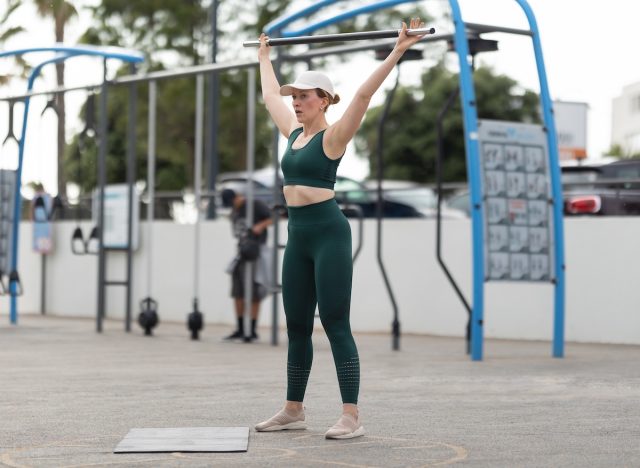When it comes to adhering to a regular exercise regimen, finding the time can prove to be a hurdle. For individuals contending with packed workdays and personal engagements, weekends offer a chance to make up for missed workout sessions. To maximize these valuable weekend moments, careful planning is key, especially if you’re incorporating a method known as “exercise stacking.”
Exercise stacking involves combining different types of workouts back-to-back with minimal rest in between. This approach boosts efficiency and allows you to target various muscle groups effectively. However, to execute this technique successfully, adequate preparation and organization are essential.
In this article, I’m breaking down exactly how long you should work out if you’re exercise stacking on weekends, the best ways to program your workouts, how to balance work and rest durations for your fitness routine, and the importance of recovery. Continue reading to learn more, and when you’re finished, don’t miss Here’s How Long You Need To Walk Every Day for Weight Loss.
Here’s how long you should work out when exercise stacking on weekends:

Exercise stacking involves combining multiple forms of exercise within a single session to optimize time efficiency and fitness gains. Rather than dedicating separate time slots for cardio, strength training, and flexibility exercises, individuals practicing exercise stacking aim to integrate these components seamlessly into their workouts. While this approach can be highly effective, determining the ideal duration for each session becomes crucial to achieving the perfect balance between effectiveness and sustainability.
The optimal duration for a stacked workout session typically ranges anywhere from 45 minutes to 90 minutes, depending on various factors such as fitness level, intensity, and specific goals. For beginners, starting with shorter sessions and gradually increasing the duration as endurance improves is advisable. Intermediate and advanced individuals may benefit from longer sessions to accommodate the higher intensity and greater volume of exercises.
Programming your workouts for exercise stacking:

To optimize your stacked workouts, it’s essential to program each session thoughtfully. A well-rounded session typically includes three key components: warm-up, strength training, and cool-down:
1. Warm-up
Begin your workout with a dynamic warm-up to prepare your body for the upcoming exercises. Incorporate dynamic stretches, mobility drills, and light cardiovascular activities to increase blood flow, loosen tight muscles, and enhance joint flexibility. Aim for five to 10 minutes of dynamic movements tailored to the specific muscles and movements you’ll be targeting during your workout.
2. Strength Training
Next, transition into the strength training segment of your session, focusing on compound exercises that engage multiple muscle groups simultaneously. Choose exercises that align with your fitness goals, whether building strength, increasing muscle mass, or improving muscular endurance. Perform each exercise with proper form and technique, and adjust the weight and repetitions based on your fitness level and desired intensity.
3. Cool-down
After completing your strength training exercises, transition into the cool-down phase to facilitate recovery and reduce muscle soreness. Incorporate static stretches that target the major muscle groups you worked on during your session, holding each stretch for 20 to 30 seconds to promote flexibility and relaxation.
Additionally, consider incorporating foam rolling or self-myofascial release techniques to alleviate muscle tension and improve recovery.
How to balance work and rest durations for various workouts:

While the duration and layout of a stacked workout session are essential, it’s equally as important to consider the intensity of each exercise component. Striking the right balance ensures you maximize strength development, calorie burn, muscle engagement, and cardiovascular benefits without risking burnout or overtraining.
Strength Training
For strength workouts, the focus is lifting heavy weights to stimulate muscle growth and increase strength. For optimal results, incorporate adequate rest intervals between sets for sufficient recovery and maximize performance. Rest intervals for strength-focused workouts typically range from two to five minutes between sets. This extended rest period allows the muscles to replenish and recover from the high-intensity effort of lifting heavy weights.
Hypertrophy-focused Workouts
Hypertrophy-focused workouts often utilize shorter rest intervals, typically around 60 to 90 seconds between sets. This shorter rest period helps maintain a higher level of metabolic stress, which is conducive to muscle hypertrophy.
High-intensity Interval Training (HIIT)
High-intensity interval training (HIIT) is a popular choice for those practicing exercise stacking due to its efficiency in burning calories and improving cardiovascular health. Integrating short bursts of intense activity with brief recovery periods accelerates fat loss and enhances endurance and metabolic rate. However, the intensity of HIIT workouts necessitates shorter overall durations to prevent excessive strain on the body.
The importance of recovery:

Amidst the enthusiasm for maximizing weekend workouts through exercise stacking, it’s essential not to overlook the significance of rest and recovery. While pushing your limits can lead to substantial fitness gains, failing to allow adequate time for recovery can increase the risk of injury, fatigue, and burnout.
Rest days into your weekly routine allow muscles to repair and rebuild, prevent overuse injuries, and replenish energy stores. Moreover, prioritizing quality sleep, proper nutrition, and stress management practices further supports the body’s recovery process, ensuring you’re ready to tackle your next stacked workout session with vigor and enthusiasm.
Frequently Asked Questions (FAQs)
What is exercise stacking?
Exercise stacking is a technique where you break up your workout into smaller, more manageable chunks throughout the day instead of doing it all at once. This can help make exercise more accessible and easier to fit into a busy schedule.
How long should each exercise stacking session be?
The length of each exercise stacking session can vary depending on your schedule and fitness goals. It generally recommended to aim for at least 10-15 minutes per session to receive the benefits of exercise, but you can also choose to do longer sessions if you prefer.
Can I combine different types of exercises during an exercise stacking session?
Yes, you can mix and match different types of exercises during each stacking session. This can help keep your workouts interesting and target different muscle groups for a well-rounded fitness routine.
How many times a day should I do exercise stacking?
The number of exercise stacking sessions you do in a day is up to your personal preference and schedule. Some people may choose to do 2-3 sessions a day, while others may opt for more frequent, shorter sessions. Listen to your body and adjust accordingly.






